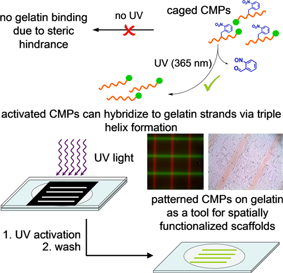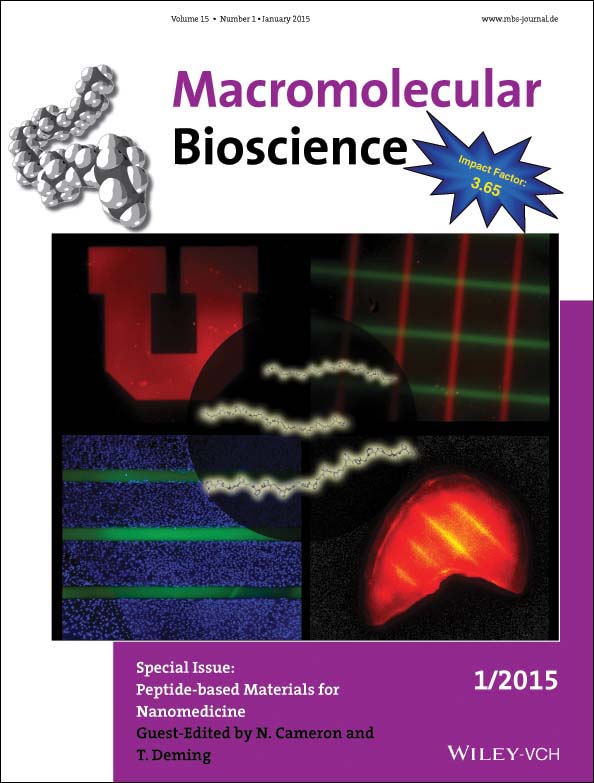Non-Covalent Photo-Patterning of Gelatin Matrices Using Caged Collagen Mimetic Peptides
Yang Li
Department of Bioengineering, University of Utah, 36 S. Wasatch Drive, 3100 SMBB, Salt Lake City, Utah, 84112 USA
Search for more papers by this authorBoi Hoa San
Department of Bioengineering, University of Utah, 36 S. Wasatch Drive, 3100 SMBB, Salt Lake City, Utah, 84112 USA
Search for more papers by this authorJulian L. Kessler
Department of Bioengineering, University of Utah, 36 S. Wasatch Drive, 3100 SMBB, Salt Lake City, Utah, 84112 USA
Search for more papers by this authorJin Hwan Kim
Department of Bioengineering, University of Utah, 36 S. Wasatch Drive, 3100 SMBB, Salt Lake City, Utah, 84112 USA
Search for more papers by this authorQingguo Xu
Center for Nanomedicine, Wilmer Eye Institute, Johns Hopkins University School of Medicine, Baltimore, Maryland, 21231 USA
Search for more papers by this authorJustin Hanes
Center for Nanomedicine, Wilmer Eye Institute, Johns Hopkins University School of Medicine, Baltimore, Maryland, 21231 USA
Search for more papers by this authorCorresponding Author
Seungju Michael Yu
Department of Bioengineering, University of Utah, 36 S. Wasatch Drive, 3100 SMBB, Salt Lake City, Utah, 84112 USA
E-mail:
Search for more papers by this authorYang Li
Department of Bioengineering, University of Utah, 36 S. Wasatch Drive, 3100 SMBB, Salt Lake City, Utah, 84112 USA
Search for more papers by this authorBoi Hoa San
Department of Bioengineering, University of Utah, 36 S. Wasatch Drive, 3100 SMBB, Salt Lake City, Utah, 84112 USA
Search for more papers by this authorJulian L. Kessler
Department of Bioengineering, University of Utah, 36 S. Wasatch Drive, 3100 SMBB, Salt Lake City, Utah, 84112 USA
Search for more papers by this authorJin Hwan Kim
Department of Bioengineering, University of Utah, 36 S. Wasatch Drive, 3100 SMBB, Salt Lake City, Utah, 84112 USA
Search for more papers by this authorQingguo Xu
Center for Nanomedicine, Wilmer Eye Institute, Johns Hopkins University School of Medicine, Baltimore, Maryland, 21231 USA
Search for more papers by this authorJustin Hanes
Center for Nanomedicine, Wilmer Eye Institute, Johns Hopkins University School of Medicine, Baltimore, Maryland, 21231 USA
Search for more papers by this authorCorresponding Author
Seungju Michael Yu
Department of Bioengineering, University of Utah, 36 S. Wasatch Drive, 3100 SMBB, Salt Lake City, Utah, 84112 USA
E-mail:
Search for more papers by this authorAbstract
To address the downside of conventional photo-patterning which can alter the chemical composition of protein scaffolds, we developed a non-covalent photo-patterning strategy for gelatin (denatured collagen) hydrogels that utilizes UV activated triple helical hybridization of caged collagen mimetic peptide (caged CMP). Here we present 2D and 3D photo-patterning of gelatin hydrogels enabled by the caged CMP derivatives, as well as creation of concentration gradients of CMPs. CMP's specificity for binding to gelatin allows patterning of almost any synthetic or natural gelatin-containing matrix, such as gelatin-methacrylate hydrogels and corneal tissues. This is a radically new tool for immobilizing drugs to natural tissues and for functionalizing scaffolds for complex tissue formation.
References
- 1 G. H. Underhill, G. Peter, C. S. Chen, S. N. Bhatia, Annu. Rev. Cell Dev. Biol. 2012, 28, 385.
- 2 C. A. DeForest, B. D. Polizzotti, K. S. Anseth, Nat. Mater. 2009, 8, 659.
- 3 C. A. DeForest, K. S. Anseth, Nat. Chem. 2011, 3, 925.
- 4 Y. Luo, M. S. Shoichet, Nat. Mater. 2004, 3, 249.
- 5 J. H. Wosnick, M. S. Shoichet, Chem. Mater. 2007, 20, 55.
- 6 R. G. Wylie, M. S. Shoichet, J. Mater. Chem. 2008, 18, 2716.
- 7 R. G. Wylie, S. Ahsan, Y. Aizawa, K. L. Maxwell, C. M. Morshead, M. S. Shoichet, Nat. Mater. 2011, 10, 799.
- 8 M. S. Hahn, J. S. Miller, J. L. West, Adv. Mater. 2005, 17, 2939.
- 9 M. S. Hahn, L. J. Taite, J. J. Moon, M. C. Rowland, K. A. Ruffino, J. L. West, Biomaterials 2006, 27, 2519.
- 10 M. S. Hahn, J. S. Miller, J. L. West, Adv. Mater. 2006, 18, 2679.
- 11 V. L. Tsang, A. A. Chen, L. M. Cho, K. D. Jadin, R. L. Sah, S. DeLong, J. L. West, S. N. Bhatia, FASEB J. 2007, 21, 790.
- 12 S.-H. Lee, J. J. Moon, J. L. West, Biomaterials 2008, 29, 2962.
- 13 J. L. West, Nat. Mater. 2011, 10, 727.
- 14 J. C. Culver, J. C. Hoffmann, R. A. Poché, J. H. Slater, J. L. West, M. E. Dickinson, Adv. Mater. 2012, 24, 2344.
- 15 C. M. Rubert, A. Pérez, J. Panitch, Chmielewski, Macromol. Biosci. 2011, 11, 1426.
- 16 A. M. Kloxin, A. M. Kasko, C. N. Salinas, K. S. Anseth, Science 2009, 324, 59.
- 17 J. W. Nichol, S. T. Koshy, H. Bae, C. M. Hwang, S. Yamanlar, A. Khademhosseini, Biomaterials 2010, 31, 5536.
- 18 J. E. Park, G. A. Keller, N. Ferrara, Mol. Biol. Cell 1993, 4, 1317.
- 19 C. G. Knight, L. F. Morton, A. R. Peachey, D. S. Tuckwell, R. W. Farndale, M. J. Barnes, J. Biol. Chem. 2000, 275, 35.
- 20 A. Hoshikawa, Y. Nakayama, T. Matsuda, H. Oda, K. Nakamura, K. Mabuchi, Tissue Eng. 2006, 12, 2333.
- 21 T. Mazaki, Y. Shiozaki, K. Yamane, A. Yoshida, M. Nakamura, Y. Yoshida, D. Zhou, T. Kitajima, M. Tanaka, Y. Ito, T. Ozaki, A. Matsukawa, Sci. Rep. 2014.
- 22 Z. S. Patel, S. Young, Y. Tabata, J. A. Jansen, M. E. K. Wong, A. G. Mikos, Bone 2008, 43, 931.
- 23 X. Hu, L. Ma, C. Wang, C. Gao, Macromol. Biosci. 2009, 9, 1194.
- 24 F.-M. Chen, R. Chen, X.-J. Wang, H.-H. Sun, Z.-F. Wu, Biomaterials 2009, 30, 5215.
- 25 Y. Li, S. M. Yu, Curr. Opin. Chem. Biol. 2013, 17, 968.
- 26 S. M. Yu, Y. Li, D. Kim, Soft Matter 2011, 7, 7927.
- 27 A. Y. Wang, X. Mo, C. S. Chen, S. M. Yu, J. Am. Chem. Soc. 2005, 127, 4130.
- 28 A. Y. Wang, C. A. Foss, S. Leong, X. Mo, M. G. Pomper, S. M. Yu, Biomacromolecules 2008, 9, 1755.
- 29 A. Y. Wang, S. Leong, Y. C. Liang, R. C. C. Huang, C. S. Chen, S. M. Yu, Biomacromolecules 2008, 9, 2929.
- 30 H. J. Lee, J.-S. Lee, T. Chansakul, C. Yu, J. H. Elisseeff, S. M. Yu, Biomaterials 2006, 27, 5268.
- 31 Y. Li, C. A. Foss, D. D. Summerfield, J. J. Doyle, C. M. Torok, H. C. Dietz, M. G. Pomper, S. M. Yu, Proc. Natl. Acad. Sci. USA 2012, 109, 14767.
- 32 Y. Li, D. Ho, H. Meng, T. R. Chan, B. An, H. Yu, B. Brodsky, A. S. Jun, S. Michael, Yu, Bioconjug. Chem. 2013, 24, 9.
- 33 X. Mo, Y. J. An, C. S. Yun, S. M. Yu, Angew. Chem. Int. Ed. 2006, 45, 2267.
- 34 H. J. Lee, C. Yu, T. Chansakul, N. S. Hwang, S. Varghese, S. M. Yu, J. H. Elisseeff, Tissue Eng. Part A 2008, 14, 1843.
- 35 Y. Li, C. A. Foss, M. G. Pomper, S. M. Yu, J. Vis. Exp. 2014, e51052.
- 36 C. Kojima, T. Suehiro, T. Tada, Y. Sakamoto, T. Waku, N. Tanaka, Soft Matter 2011, 7, 8991.
- 37 T. R. Chan, P. J. Stahl, S. M. Yu, Adv. Funct. Mater. 2011, 21, 4252.
- 38 P. J. Stahl, S. M. Yu, Soft Matter 2012, 8, 10409.
- 39 C. Y. Fan, C. C. Huang, W. C. Chiu, C. C. Lai, G. G. Liou, H. C. Li, M. Y. Chou, FASEB J. 2008, 22, 3795.
- 40 M. M. Pires, D. E. Przybyla, J. Chmielewski, Angew. Chem. Int. Ed. 2009, 48, 7813.
- 41 T. Okada, C. Isobe, T. Wada, S. Ezaki, N. Minoura, Bioconjug. Chem. 2013, 24, 841.
- 42 N. Sarkar, J. Banerjee, A. J. Hanson, A. I. Elegbede, T. Rosendahl, A. B. Krueger, A. L. Banerjee, S. Tobwala, R. Wang, X. Lu, S. Mallik, D. K. Srivastava, Bioconjug. Chem. 2008, 19, 57.
- 43 A. J. Kuijpers, G. H. M. Engbers, J. Krijgsveld, S. A. J. Zaat, J. Dankert, J. Feijen, Biomater. Sci., Polym. Ed. 2000, 11, 225.
- 44 P. J. Stahl, T. R. Chan, Y.-I. Shen, G. Sun, S. Gerecht, S. M. Yu, Adv. Funct. Mater. 2014, 24, 3213.
- 45 S. Kim, H. J. Kim, N. L. Jeon, Integr. Biol. 2010, 2, 584.
- 46 S. Ostrovidov, N. Annabi, A. Seidi, M. Ramalingam, F. Dehghani, H. Kaji, A. Khademhosseini, Anal. Chem. 2012, 84, 1302.
- 47 B. Schnüriger, G. Barmparas, B. C. Branco, T. Lustenberger, K. Inaba, D. Demetriades, Am. J. Surg. 201.
- 48 B. W. J. Hellebrekers, T. C. M. Trimbos-Kemper, J. B. M. Z. Trimbos, J. J. Emeis, T. Kooistra, Fertil. Steril. 2000, 74, 203.
- 49 C. M. Rubert, L. A. Perez, J. Rank, Chmielewski, Chem. Commun. 2014.
- 50 G. C. R. Ellis-Davies, Nat. Methods 2007, 4, 619.
- 51 A. L. Paguirigan, D. J. Beebe, Nat. Protoc. 2007, 2, 1782.
- 52 S. Young, M. Wong, Y. Tabata, A. G. Mikos, J. Controlled Release 2005, 109, 256.
- 53 D. Olsen, C. Yang, M. Bodo, R. Chang, S. Leigh, J. Baez, D. Carmichael, M. Perälä, E.-R. Hämäläinen, M. Jarvinen, J. Polarek, Adv. Drug Deliv. Rev. 2003, 55, 1547.
- 54 J. Vandooren, N. Geurts, E. Martens, P. E. Van den Steen, G. Opdenakker, Nat. Methods 2013, 10, 211.
- 55 A. J. Engler, S. Sen, H. L. Sweeney, D. E. Discher, Cell 2006, 126, 677.
- 56 L. E. Bertassoni, M. Cecconi, V. Manoharan, M. Nikkhah, J. Hjortnaes, A. L. Cristino, G. Barabaschi, D. Demarchi, M. R. Dokmeci, Y. Yang, A. Khademhosseini, Lab Chip 2014, 14, 2202.
- 57 R. Gauvin, Y.-C. Chen, J. W. Lee, P. Soman, P. Zorlutuna, J. W. Nichol, H. Bae, S. Chen, A. Khademhosseini, Biomaterials 2012, 33, 3824.
- 58 A. Dolatshahi-Pirouz, M. Nikkhah, A. K. Gaharwar, B. Hashmi, E. Guermani, H. Aliabadi, G. Camci-Unal, T. Ferrante, M. Foss, D. E. Ingber, A. Khademhosseini, Sci. Rep. 2014.
- 59 G. Eng, B. W. Lee, H. Parsa, C. D. Chin, J. Schneider, G. Linkov, S. K. Sia, G. Vunjak-Novakovic, Proc. Natl. Acad. Sci. USA 2013, 110, 4551.
- 60 S. Chattopadhyay, C. J. Murphy, J. F. McAnulty, R. T. Raines, Org. Biomol. Chem. 2012, 10, 5892.
- 61 M. N. Asiyo-Vogel, R. Brinkmann, H. Notbohm, R. Eggers, H. Lubatschowski, H. Laqua, A. Vogel, J. Cataract Refract. Surg. 1997, 23, 515.
- 62 P. Matteini, R. Cicchi, F. Ratto, D. Kapsokalyvas, F. Rossi, M. de Angelis, F. S. Pavone, R. Pini, Biophys. J. 2012, 103, 1179.
- 63 T. Theodossiou, G. S. Rapti, V. Hovhannisyan, E. Georgiou, K. Politopoulos, D. Yova, Laser Med. Sci. 2002, 17, 34.
- 64 A. Leonardi, P. Brun, G. Abatangelo, M. Plebani, A. G. Secchi, Invest. Ophthalmol. Vis. Sci. 2003, 44, 3052.
- 65 I. Lema, J. A. Durán, Ophthalmology 2005, 112, 654.
- 66 Y. Li, X. Mo, D. Kim, S. M. Yu, Biopolymers 2011, 95, 94.
- 67 Y. Tatsu, T. Nishigaki, A. Darszon, N. Yumoto, FEBS Lett. 2002, 525, 20.
- 68 P. J. Stahl, J. C. Cruz, Y. Li, S. M. Yu, K. Hristova, Anal. Biochem. 2012, 424, 137.
- 69 R. Fischer, O. Mader, G. Jung, R. Brock, Bioconjug. Chem. 2003, 14, 653.
- 70 J. Fernádez-Carneado, E. Giralt, Tetrahedron Lett. 2004, 45, 6079.




